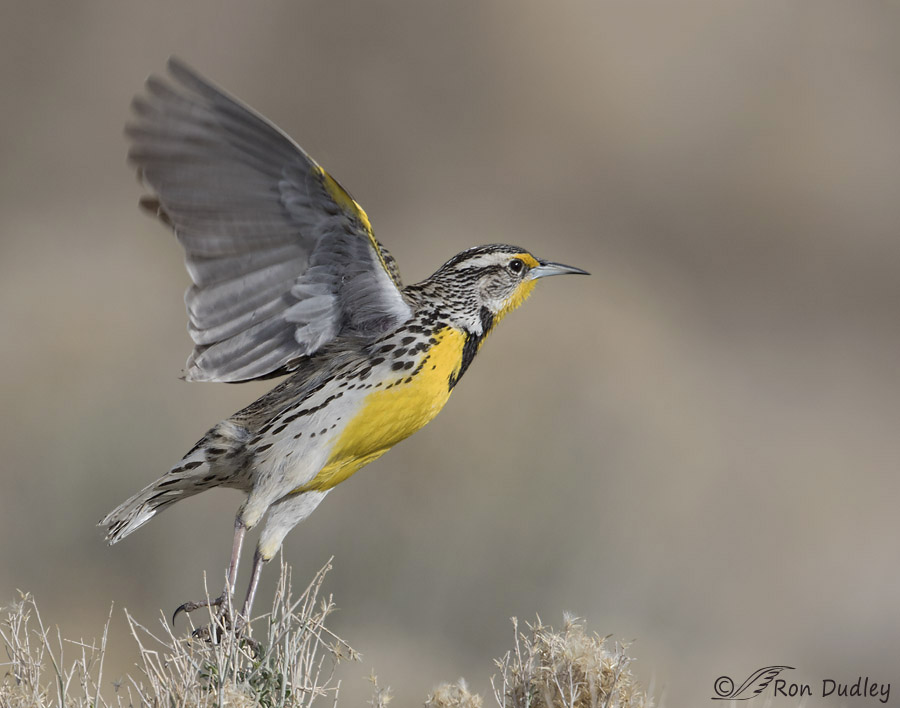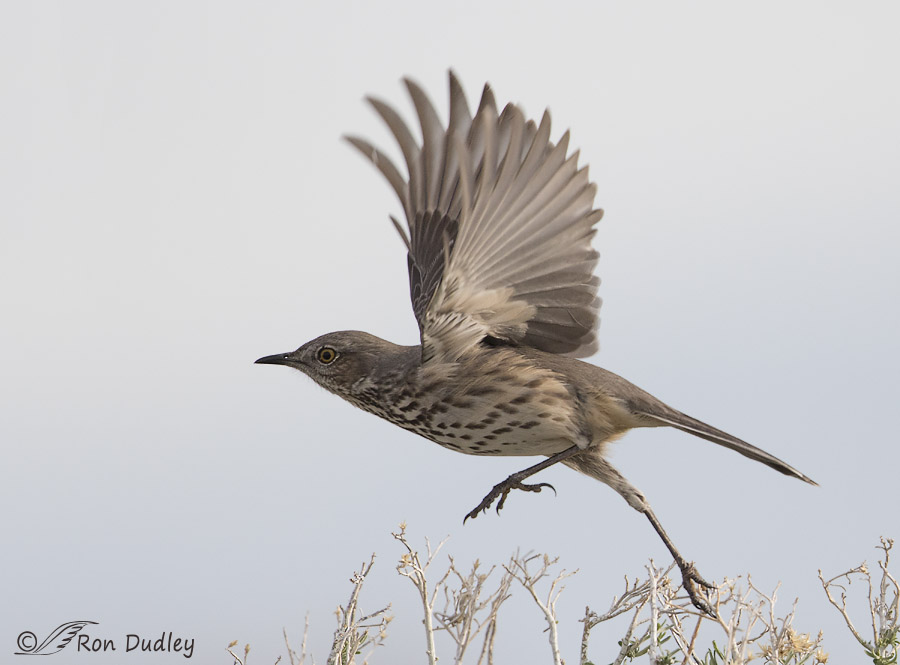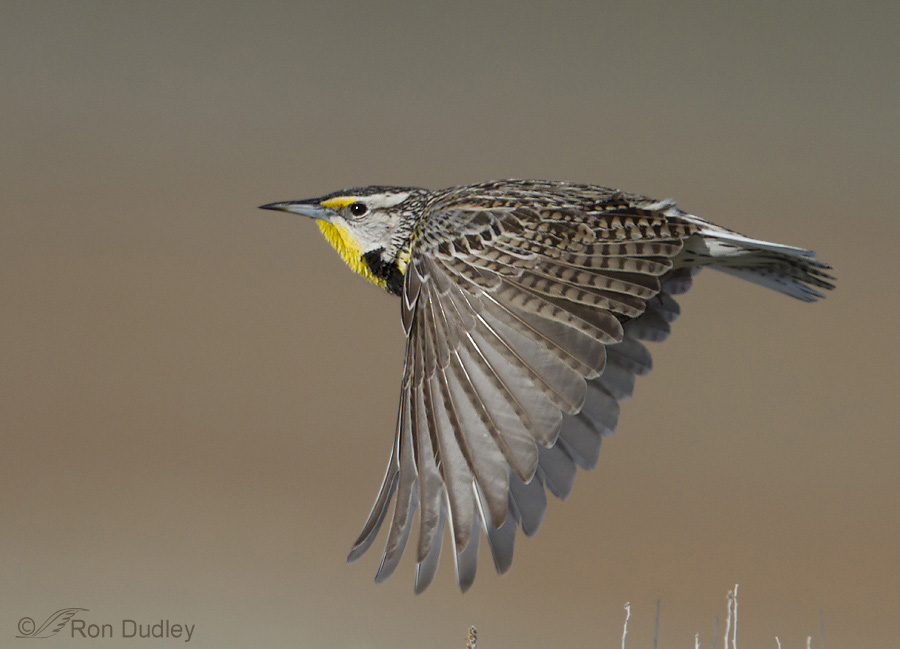Once again, a little photo-geekiness from me this morning. I know that some regular readers of Feathered Photography (especially those who are photographers themselves) sometimes wonder why I tend to use such fast shutter speeds so I thought I’d attempt an explanation.
From the years I was active on a bird photography critique site I’m keenly aware of the fact that in bird photography some folks prefer moving wing-tips to be crisp and sharp while others like the implied motion when they are blurred because it seems more natural to them. Though it’s not a strong preference for me I do slightly prefer the wingtips to be as sharp as possible so for perched birds I typically fire off a few shots at lower shutter speeds and ISO’s and then change my settings for possible take-off. In these situations, especially with passerines whose wings move much faster than larger birds, I’m often shooting with shutter speeds in the range of 1/4000 to 1/5000 sec. Here’s why.
The first two images below were taken two days ago on Antelope Island.
 1/2500, f/7.1, ISO 500, Canon 7D Mark II, Canon EF500mm f/4L IS II USM +1.4 tc, canvas added for composition, not baited, set up or called in
1/2500, f/7.1, ISO 500, Canon 7D Mark II, Canon EF500mm f/4L IS II USM +1.4 tc, canvas added for composition, not baited, set up or called in
Western Meadowlarks are among the largest songbirds I photograph so their wing speed is relatively slow but even at 1/2500 sec I have significant motion blur in the wings in this image. It doesn’t bother me particularly but given the choice (if I have enough light for faster shutter speed and my ISO isn’t too high) I’ll typically change my settings to get faster shutter speeds than this.

1/3200, f/6.3, ISO 800, Canon 7D Mark II, Canon EF500mm f/4L IS II USM +1.4 tc, not baited, set up or called in
Sage Thrashers are only 44% of the size and weight of meadowlarks (1.5 oz vs. 3.4 oz) so thrasher wing speed is much faster than that of meadowlarks. Here, 1/3200 sec still didn’t give me sharp wings for this small bird. In both images the wing-tips were close enough to the plane of the body that the softness was mostly due to shutter speed and not a depth of field issue. (I’d really have liked this shot if I’d had more light on the face)

1/4000, f/7.1, ISO 500, Canon 7D, Canon EF500mm f/4L IS II USM +1.4, not baited, set up or called in
In this older meadowlark shot (I’ve posted this one before), despite the fact that the entire bird is less sharp than those in the previous images, the faster shutter speed (1/4000 sec) has made a significant sharpness improvement in the fast moving wing tips. 1/5000 sec would have made an even larger difference. Admittedly there are other variables involved – the wing tips may have been in-between descending and ascending which would have slowed them down but typically I do get sharper wings at faster shutter speeds, as expected.
And yes, there’s sometimes a slight image quality sacrifice (more grain/noise at higher ISO’s) I make to get these faster shutter speeds but they also pay off in some of the very fast behaviors I photograph.
Much ado about nothing perhaps but I thought I owed my readers an explanation of my shutter speed “philosophy”.
Right or wrong that’s what I do. It’s just my style.
Ron


People put to much on everything being in focus,myself I love the soft edges and feeling of movement.Birds are seldom still and showing this should not be seen as a fault in bird photography.Love the shots Ron.
Sensational, amazing and unbelievable! You’re just phenomenal Ron! Thanks so much for sharing!
Charlotte
I have to say that from a visual standpoint I like the results of faster shutter speeds better, because blur hurts my eyes. One of the issues of aging, I guess. Even though my camera will always be a point and shoot (for many reasons), I always learn a lot from posts like this.
Super information, Ron. Thanks so much for the post! (Lovely images as per usual.)
I’ve been away on retreat so I’m catching up. I really like the image of the Sage Thrasher. The blur of the wings is so immediate to me. That combined with the push of the legs makes me think of a ballerina in mid-air.
Is ISO anything like VBG or LOL or BTW??? OR BFF??
Yours truly,
Clueless
Patty (AKA Clueless), – ISO is the measure of the sensitivity of the camera image sensor to light. It can be adjusted in the settings of the digital camera. The higher the ISO the more sensitive the camera is to light but the drawback of high ISO settings is that they increase grain/noise in the image and reduce fine detail.
Typically higher ISO settings are used in darker situations to get more shutter speed.
Good for you for asking!
Please, just keep on keeping on.
Coffee is now out of my life so I NEED the avian beauty to kick-start my morning.
The “avian kicks” will keep on coming, EC, though tomorrow’s post will be a variation – only a picture of a picture of a bird in the background. Something different. And personal…
thank you Ron, the light bulb went on regarding ISO and shutter speed! I felt I always was striving for an ISO of 100, now I’ll experiment!
I think you’ll be delighted with your results using higher ISO’s and shutter speeds on birds, Brenda. ISO 100 may be fine for landscape photographers but when you’re shooting fast moving birds you nearly always gain more than you lose when using higher shutter speeds.
The f4 makes a difference, also if not mistaken the 500 lens on a 7d is now 800, closer to the subject. Faster shutter speed is important, playing around with the ISO is something that takes time, but I have found on auto get some good shots. Hand held even with stabilizer 2 is not really successful, I prefer tripod, even over monopod. Your knowledge of the birds is really the key, you know your subjects and for this type of photography this is really important.
Bottom line in the digital world one cannot take as many pictures as they want, helping them to learn the camera and also learn the bird, and it does not cost a thing.
You make some good points, Steven. Thanks. And you’re right, the 500 on a 7D is effectively 800mm (1.6 crop factor) and with the 1.4 tc I’m usually using (as I was with these photos) I’m at 1120mm.
I just appreciate your photos!!! Do whatever you want; just keep me on your mailing list. I enjoy starting the day with your posts. THANKS!
Don’t worry, I will, Karen. Thank you.
The evil IPad is at it again!!! But I will NOT let it get me down…or shut me up!!!!
Glad to hear that, Patty. It just wouldn’t be the same around here without you. Or it…
I’m with you in preferring little motion blur in the wings, but the blur in the first two shots is well above my “acceptance level.” Looking at your post today, I realized that for me pleasing/non-pleasing wing blur is a function of the sharpness of the head and body. More wing blur is o.k. if head and body are not also blurred.
Excellent point, Dave. I agree with you.
I haven’t learned a thing about cameras from you, but I’ve sure learned a boat load about birds!!! I’ve also learned of I can’t see ypur blog first thing in the morning, I’m a basket case and even nastier than I am without my one cup of coffeee.
Oh my Patty, Ron better NOT take a vacation from posting! VBG!
Dick, It looks like there WILL be a vacation (camping/photo trip) in the very near future but this time I’m hoping to post from the road instead of scheduling posts before I leave. If it works there should be continuing posts while I’m gone. If it doesn’t work…..
Patty, Ha, I was wondering about that because I was over an hour late posting this morning. I thought that you and others might have thought I’d slept in.
I simply couldn’t function with only one cup of coffee in the morning…
Thanks, Ron! I never considered the size of the bird re the swiftness of the wing movement. If I ever try to photograph birds, I’ll be sure to conduct a lot of experiments.
“If I ever try to photograph birds, I’ll be sure to conduct a lot of experiments.”
Exactly, Alison. IMO, experimentation is the key to finding what works best for getting what you want. Many folks read in a book that a certain setting is best for a particular situation, never forget it, and stick with it almost forever. I was guilty of that myself for a period of time. For example, early on in my photography I once read that a particular lens I was using was sharpest at f/8 so everything I shot was at f/8. Boy did I ever ruin a lot of images doing that!
Before I became acquainted with Ron’s Blog, I was shooting in aperture priority, reading that was the way to go. When I was introduced to Ron’s Blog, I noticed that he was shooting shutter speeds between 3k to 6k speeds and getting excellent results. So, not too old to change, I did, and have never looked back, unless I’m shooting MACRO. I generally don’t want blur unless I’m looking for motion in the shot.
I appreciate your explanation, but the proof is in what we see on your blog, and I love your results, so I’ve become a student!
Dick, Actually I always shoot in aperture priority but I still generally go for those high shutter speeds for birds. That said, I continue to experiment with settings for particular situations so who knows where I’ll go in the future. It might be interesting for me to come back to this post in a year or two and see if I’ve altered my shooting style in that amount of time. Thank you.
Hi Ron,
Very nice images! I totally agree about balance between shutter speed and ISO. I’ve learned a lot from you about bird photography and I think fast shutter speed is so vital to capture that great image.
Thank you, Gary. Like so many other photographers I used to make every attempt to keep my SS and ISO’s as low as possible but as my shooting style (behaviors, flight and take-offs) evolved I found I got more shots I liked going the other way. It’s what works for me.
Since I shoot mostly handheld, fast shutter speed is always necessary. I have found from your blog you use fast shutter speed most of the time, and in following your example my keeper rate has increased considerably.
Thanks for what you do!
Dang, I loved hearing that, Gary!
Here’s another consideration I probably should have covered in this post. Folks who are shooting with lenses without image stabilization also tend to need faster shutter speeds, especially if they’re hand-holding their lens instead of using a tripod.